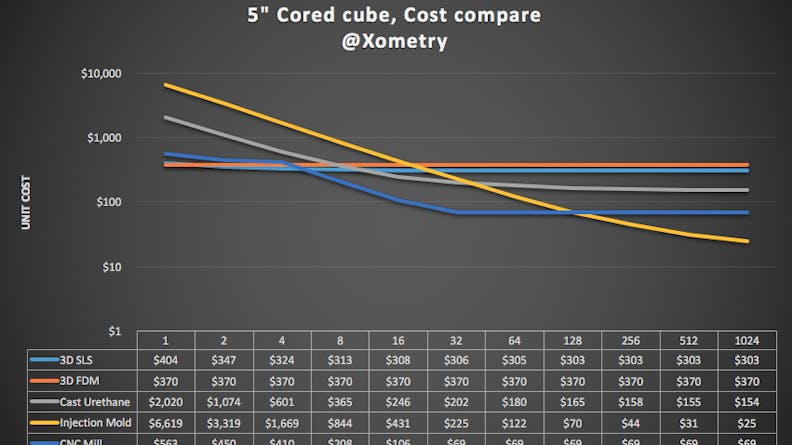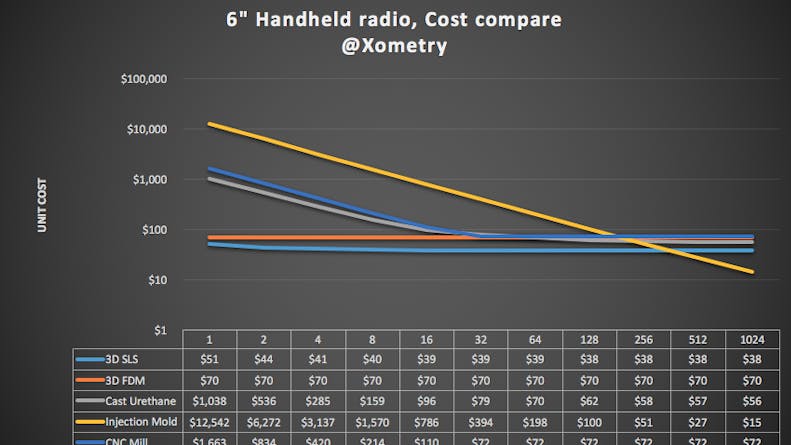
Thinking in Scale: 3 Case Studies Comparing Cost vs Quantity
Do you 3D print, cast, machine, or mold? A lot of that answer depends on how many parts you need.

Some manufacturing processes may seem like expensive options, but the price of every part depends on its circumstances. Quantity plays a huge role in how cost-effective each of your custom orders can be, and to prove this, we’ve put together the following cost analysis using Xometry’s online instant quoting tools. These three case studies show different part geometries and how their per-unit cost compares from quantity 1 to over 1000 parts. The technologies compared are selective laser sintering (SLS),fused deposition modeling (FDM),cast urethane, CNC milling, and injection molding.
Looking at the graph for this 5” Cored cube, it’s clear that Injection Molding is not the best choice at low quantities, with the tooling cost starting at ~$6,600. But what happens when your needs increase? The cost of Injection Molding steadily drops until it is the cheapest process by a landslide, at $25 a unit when ordering 1024 units (the next capability is almost double!). Certain 3D processes such as Fused Deposition Modeling and Selective Laser Sintering will level off price per unit over quantity but can be very competitive for rapid prototyping or low volume production.
Smaller pieces like a 1” Spacer actually show that 3D printing can remain extremely competitive for hundreds of units. Injection Molding’s amortized tooling cost does not catch until around 500 units. At that point it becomes a no-brainer as the per-unit price drops and isn’t slowing down even at 1000+ units.
To prove this effect is consistent for a variety of parts, shapes, and features, we ran the same analysis on this 6” Handheld radio. Its complexity makes milling out-of-the question. SLS does have a competitive price but may not hit the cosmetic needs of this part. Urethane casting starts to shine right around the 30-50 part range but eventually Injection Molding scales to achieve extremely low per unit costs by about 250 units. Looking at the slope, Injection Molding’s per unit cost likely will not level off until the price drops significantly over higher quantities.
Key Takeaways
We ran these cost-comparison tests to prove that Injection Molding is a smart process to consider for large bulk orders. We strongly suggest utilizing Injection Molding for quantities from 250 units and beyond, as the process can easily handle high quantity orders while remaining the best financial option. With Injection Molding, you have the power of scaling.
egardless of the complexity and features of your part, scaling up will almost always achieve this same effect. This is because much of the upfront cost in Injection Molding comes from making the mold itself - once that is created, it doesn’t add much cost to keep using the mold to run more and more parts. Xometry will even hold on to the mold for you for future repeat orders, but you are the owner of the mold - if you ever want to hold on to it yourself, we’ll ship it to you.
Xometry offers many subtractive and additive technologies in one place with the ability to instantly get pricing, lead time, and design feedback online. We want to service your project, whatever your needs are (from prototyping to production) and offer many tools on the site to help you decide what works best for your requirements. Sometimes it makes sense to stick with printing, sometimes it’s machining, sometimes it’s both! The process you decide on will depend on your parts, the stage of development they are in, your budget, and their intended end-use.
Our engineering and support team is passionate about finding the exact right fit for your custom parts. Talk to our team today to get insight on the manufacturing process, quantity, and end-use features that would work best for your custom parts! Reach out to us at 1-800-983-1959 or support@xometry.com.



